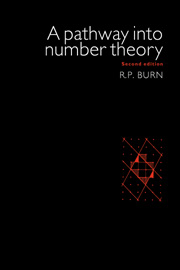Book contents
- Frontmatter
- Contents
- Preface to the second edition
- Introduction
- 1 The fundamental theorem of arithmetic
- 2 Modular addition and Euler's ɸ function
- 3 Modular multiplication
- 4 Quadratic residues
- 5 The equation xn + yn = zn, for n = 2, 3, 4
- 6 Sums of squares
- 7 Partitions
- 8 Quadratic forms
- 9 Geometry of numbers
- 10 Continued fractions
- 11 Approximation of irrationals by rationals
- Bibliography
- Index
Preface to the second edition
Published online by Cambridge University Press: 05 June 2012
- Frontmatter
- Contents
- Preface to the second edition
- Introduction
- 1 The fundamental theorem of arithmetic
- 2 Modular addition and Euler's ɸ function
- 3 Modular multiplication
- 4 Quadratic residues
- 5 The equation xn + yn = zn, for n = 2, 3, 4
- 6 Sums of squares
- 7 Partitions
- 8 Quadratic forms
- 9 Geometry of numbers
- 10 Continued fractions
- 11 Approximation of irrationals by rationals
- Bibliography
- Index
Summary
With industrial warfare over public key cryptography and the proof of Fermat's last theorem, number theory has been uncharacteristically in the public eye since the publication of the first edition of the Pathway. This second edition includes a section on RSA codes (for which the necessary theory was already in the first edition), more material than before on Gaussian integers, a section on triangular numbers, and substantially revised historical notes. Most of the improvements are due to the advice of Catherine Goldstein (Paris-Sud) to whom I am deeply grateful.
From time to time I have been asked how to use the Pathway for an undergraduate course. The problem sequence was originally put together for a course without lectures. Where student numbers are large this may not be feasible. None the less the existence of the Pathway may still enable lecturers to structure their students’ learning more creatively. Conventionally in undergraduate mathematics, the initiation of mathematics comes in a lecture to which the expected response is the solution of exercises and problems. This seemingly logical sequence of input and response takes insufficient account of how learning happens. It is only mathematical activity and reflection on that activity which generates understanding, and a lecturer's input may be better placed after students have generated the basic notions and conjectured some of the theorems through concrete exercises, and before the harder proof-formulation and problem-solving is attempted. It is this restructuring which the Pathway makes feasible. The central point of the Pathway is to enable students to participate in the formulation of central mathematical ideas before a formal treatment (which, suitably introduced, they may well be able to provide themselves). The amount of time for the course is not at issue: just how that time is used is what is at stake.
- Type
- Chapter
- Information
- A Pathway Into Number Theory , pp. xi - xiiPublisher: Cambridge University PressPrint publication year: 1996



